What are the best sweeteners for the keto diet? Check out this comprehensive guide to baking with sugar substitutes, and learn how to get the taste and texture you crave!
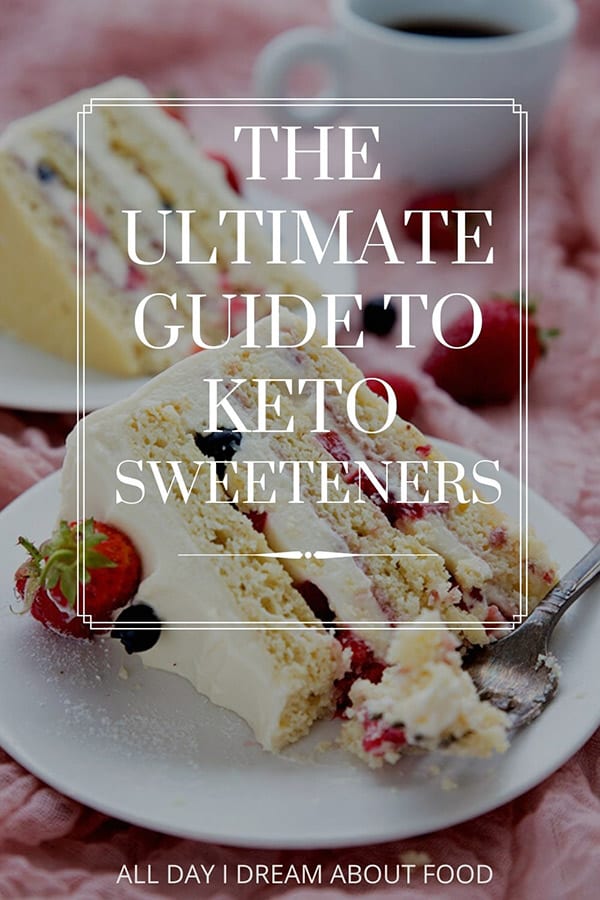
Today, my keto friends, I am imparting some of my vital knowledge and deep wisdom about using keto sweeteners. We will discuss all of their pros and cons, and how they affect the outcome of your keto desserts.
In advance of the holiday baking season, I figured you could put this information to good use. Because if you’re anything like me, you like to get an early jump on your keto holiday cookies!
This is actually an abridged version of the in-depth keto sweetener section in my book, The Ultimate Guide to Keto Baking. I think you will find it very informative.

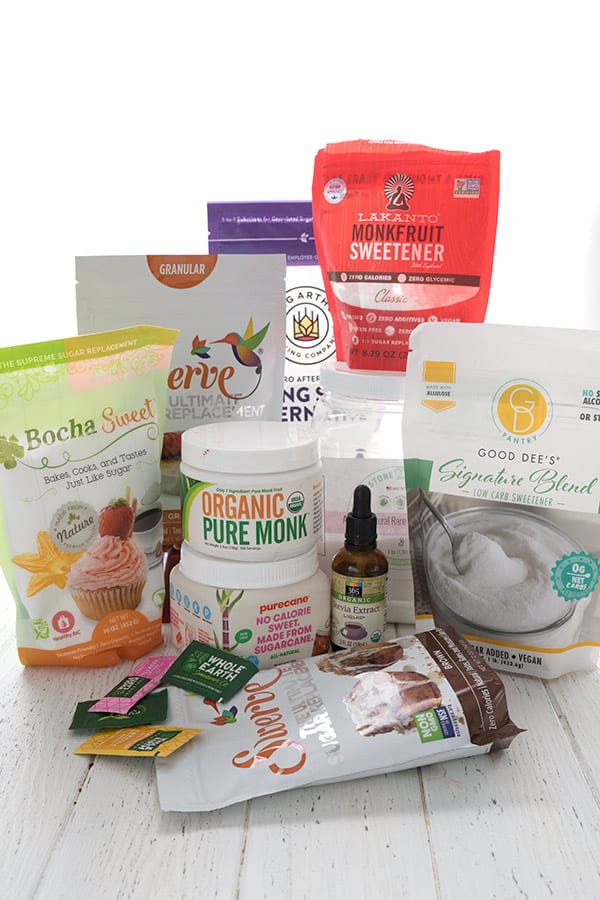
What is the best keto sweetener?
I’m sorry, I simply cannot answer that for you.
I’m not being willful or stubborn, or deliberately withholding information. It’s simply that there is no such thing. Yes, you read that right – there is no such thing as the best keto sweetener.
Here’s why: Everyone experiences these sugar substitutes differently. It’s almost as individual as the individual themselves.
- Some people experience an unpleasant aftertaste with one and not another.
- Some people suffer from GI issues or headaches when consuming certain sweeteners.
- Some people see a blood sugar rise when other people do not.
- Some people may even experience an allergic reaction to certain sweeteners.
With the sugar substitutes market constantly expanding and changing, it’s much more about finding what sweeteners work best FOR YOU.
What are the best sweeteners for keto baking?
Ah, now we’re on to something. This is my territory and one that I have researched extensively. I have experimented with a wide array of sugar substitutes and I can tell you straight up that none of them behaves exactly like sugar.
They all have very different properties and the sweetener(s) you choose will impact the outcome of your recipes. The trick is to understand their different attributes and use them to advantage.
Consider the final product before choosing your sugar substitutes. What are you trying to make? What consistency are you trying to achieve? Do you want it crisp or soft? Chewy or cakey? Should it be gooey or firm?
Most of the popular brands on the market are actually blends of two or more keto sweeteners. For simplicity’s sake, I am going to break them down into their main ingredients.
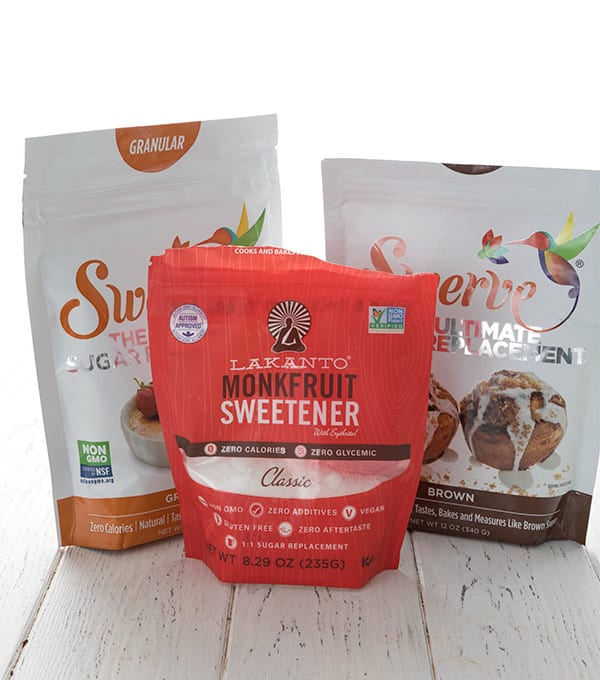
Erythritol
What is it?
Erythritol is a sugar alcohol (polyol) that is naturally present in some fruits and fermented foods. For mass production, it is made by fermenting a glucose syrup with enzymes.
It is unique among sugar alcohols in that it has zero carb impact. Our bodies simply do not recognize it as a carb so it does not impact blood sugar at all. And unlike many sugar alcohols, it does not cause gastrointestinal issues for most people.
How does it work?
Similar to sugar:
– Erythritol mimics sugar in its crystalline structure, so it helps whip air into butter and egg whites.
– It also browns and crisps up nicely and it can even be coaxed into caramelizing.
Differs from sugar:
– It’s only 70% as sweet as sugar, which is why most brands combine it with other sweeteners, to make it measure cup for cup.
– It’s non-hygroscopic, meaning that unlike sugar, it does not attract or hold onto moisture, which can cause baked goods to be dry and crumbly if they don’t have enough fat.
– It can re-crystallize as it cools, particularly in liquid applications like sauces, custards, and ice cream.
– Some people experience a mouth-cooling sensation, similar to sucking on a mint. Not everyone experiences this, and often mixing it with other sweeteners eliminates this sensation.
Major Brand Names: Swerve, Lakanto (this is mostly erythritol… do not be fooled by the fact that it calls itself a “monk fruit sweetener”), So Nourished, ZSweet.
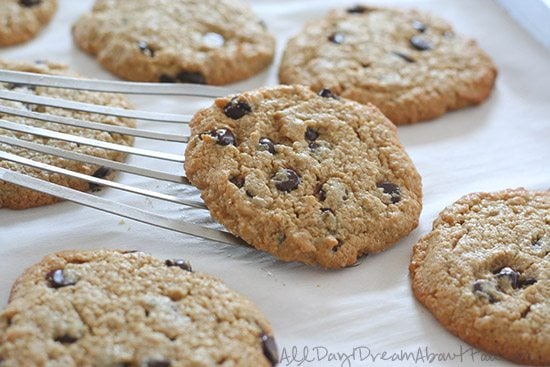
Xylitol
What is it?
Xylitol is also a sugar alcohol found in some fruits and vegetables, as well as in wood and corn. It is usually manufactured commercially from corn or birch trees.
Some, but not all, xylitol is absorbed by the intestines into the bloodstream. This means it can cause some gastrointestinal discomfort when consumed in large amounts. It can also have an impact on blood sugar.
WARNING! The biggest issue with xylitol is that it is highly toxic to dogs.
How does it work?
Similar to sugar:
– It has a crystalline structure so it can whip air bubbles into butter and egg whites. It’s also as sweet as sugar.
– It’s more hygroscopic than erythritol so it attracts moisture and it doesn’t re-crystallize as it cools. Xylitol is great for ice creams and sauces to keep them soft.
Differs from sugar:
– Xylitol doesn’t caramelize or crisp up very well. This can cause problems for baked goods that need a crisp texture, like many keto cookies. They will turn out much more cakey and soft if you use xylitol.
– Definitely do NOT use for meringue, as it will stay gooey and soft, and won’t come off the parchment paper.
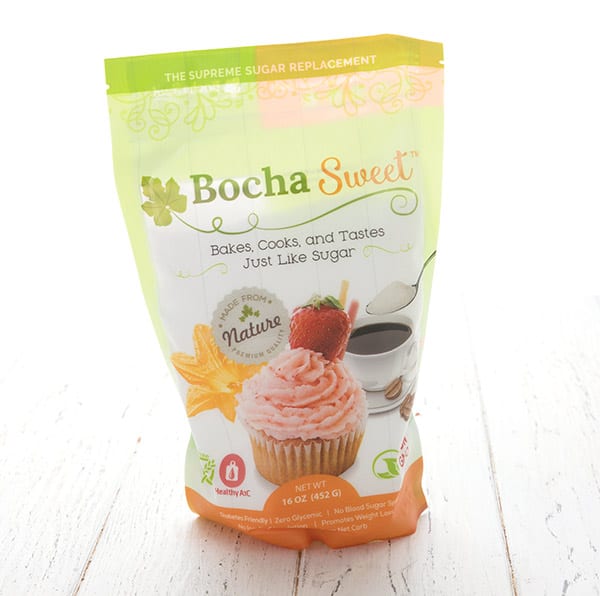
BochaSweet
What is it?
BochaSweet is the brand name of a unique sweetener derived from the kabocha squash, a type of winter squash also know as Japanese pumpkin.
Like erythritol, it seems to have little to no impact on most people’s blood sugar. But like xylitol, it can cause some gastrointestinal upset when consumed in large quantities.
In many ways, BochaSweet functions a lot like xylitol (they are both pentose sweeteners), but it does not appear to be toxic to household pets.
How does it work?
Similar to sugar:
– BochaSweet is as sweet as sugar and so can be used as a cup-for-cup replacement, without an apparent aftertaste.
– It is more hygroscopic and doesn’t re-crystallize so it’s great in sauces, custards, and ice creams. (I have started using it in combination with Swerve in all of my keto ice cream… they stay scoopable even straight from the freezer!).
Differs from sugar:
– Just like xylitol, BochaSweet will not crisp up or brown very well. Cookies end up soft and cakey, and meringues are so gooey that they won’t come off the paper.
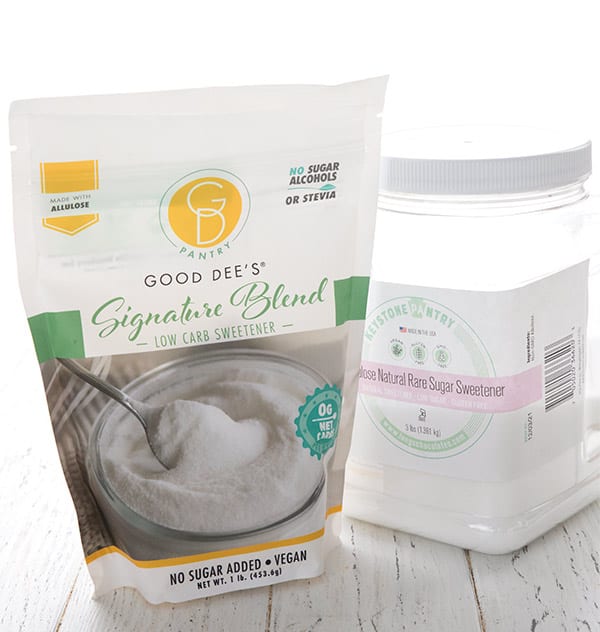
Allulose
What is it?
Allulose is a relative newcomer on the sugar alternative scene and has become incredibly popular. It is a monosaccharide, which means it really is a “sugar”, but one that our bodies don’t treat like a sugar or a carb. It is largely excreted without ever affecting blood glucose levels.
However, I caution you from personal experience that large amounts can cause serious GI distress. Many people don’t seem to suffer from this, but some of us do and it’s…not fun.
So it’s worth testing on yourself in small amounts and building up from there.
How does it work?
Similar to sugar:
– Allulose caramelizes nicely and tends to be hygroscopic, keeping sauces and ice creams soft, and baked goods tender.
Differs from sugar:
– Allulose is only 70% as sweet, which means you need more to sweeten your desserts.
– While it caramelizes well, it doesn’t crisp up well and baked goods tend to be soft and cakey. Even just a little allulose, in combination with other sweeteners, can prevent your cookies from becoming crisp.
– It can over-brown the outside of baked goods, especially the parts that are touching the sides of the pan. Cakes can have a dark, almost burnt appearance, although they aren’t over-cooked.
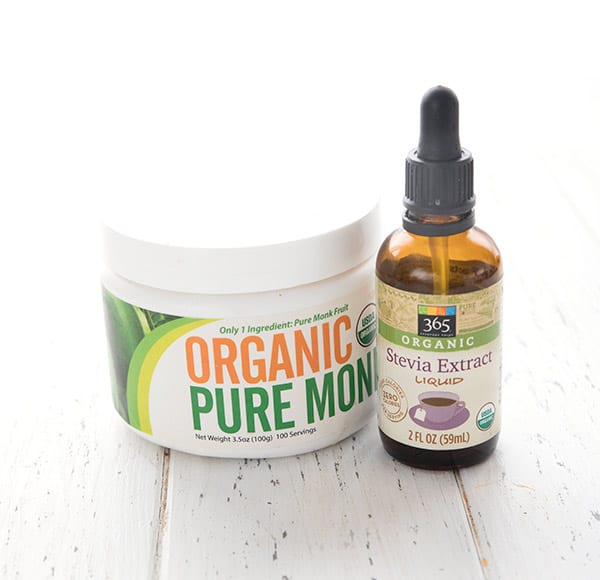
Stevia and Monk Fruit
I am lumping these two together because they have many similar properties and behave much the same way.
What are they?
Both stevia and monkfruit are naturally derived, plant-based sweeteners that are hundreds of times sweeter than sugar. Because they are extremely concentrated, a tiny amount can sweeten a whole recipe.
While that may sound like a good thing, it can have major implications for your keto baked goods. Read on…
How do they work?
Concentrated sweeteners like these have no “bulk” – they have little in the way of weight or volume so they don’t add much to your recipe other than sweetness. They can’t contribute anything to texture or consistency, and they don’t caramelize, crisp, or brown your baked goods.
Bulk is an important factor in anything from cupcakes to frosting. Substituting a non-bulk sweetener means your keto treats may not rise properly, may be more fragile, and may not set properly.
“Monk fruit sweetener”
Please be aware that many brands that bill themselves as “monk fruit sweetener” are actually mostly erythritol. The main ingredient is erythritol, with a little monk fruit to make it sweeter. This means that the sweetener will behave mostly like erythritol.
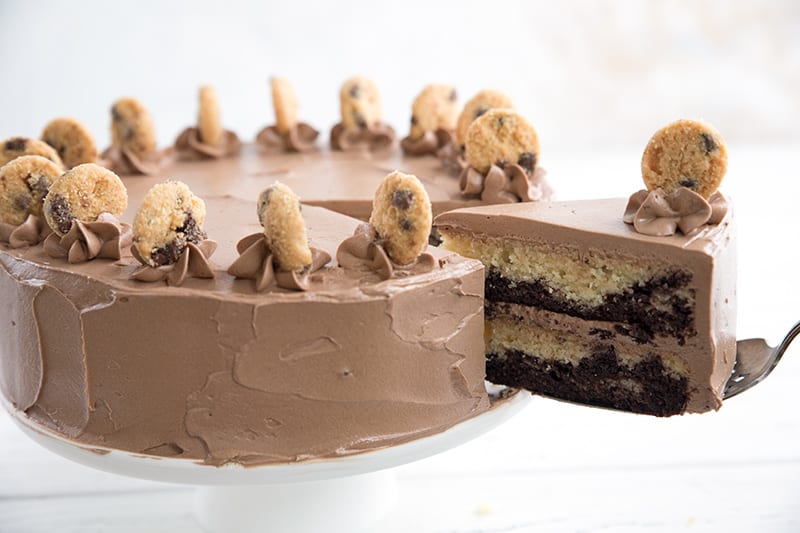
How to use sugar substitutes
I’ve thrown a ton of information at you and I know it’s hard to digest it all. I do this for a living and still I have times when a certain sweetener doesn’t behave the way I think it should. But here’s a quick cheat sheet on what to use when:
Want crisp keto cookies? Use erythritol based sweeteners like Swerve, Lakanto, or So Nourished. Other options will make your cookies soft and cakey. I highly recommend Swerve Brown for the best brown sugar substitute for cookies!
Making a keto cake recipe? Use any sweetener that has bulk (erythritol, BochaSweet, xylitol or allulose), but do be forewarned that some are not quite as sweet as sugar and you may need more of them.
Making a keto frosting? You need a bulk powdered sweetener to give your frosting structure. Erythritol, xylitol, and BochaSweet all have confectioners (powdered) versions. Allulose may as well but I am unsure of brands.
Want a gooey consistency? Try using BochaSweet or allulose, or combine it with another erythritol based sweetener. This combo is perfect for things like keto caramel sauce or my keto pecan pie.
Want keto ice cream that stays scoopable for days? My recommendation is half Swerve and half BochaSweet or allulose. Using only erythritol based sweeteners makes your ice cream rock hard, and all BochaSweet makes it too soft (it stays like soft serve!).
Just trying to sweeten your coffee? Use whatever you like best. They all work well if you don’t need a certain consistency so this is a matter of personal preference.
Still have questions?
Leave a comment and I will do my best to answer!
Adding to the confusion is that many brands on the market are blends of the keto sweeteners I outlined above. Blending sugar substitutes can maximize their sweetness and reduce potential aftertastes.
But I’ve tried such a wide array of sweeteners, I have a good idea of how most of them work. I can also take an educated guess based on the ingredients list. So drop me a line and I will give you all the information I can.

Free Bonus: Secrets to Keto Baking!
Sign up for your favorite recipes delivered straight to your inbox plus get our FREE bonus: Secrets to Keto Baking!


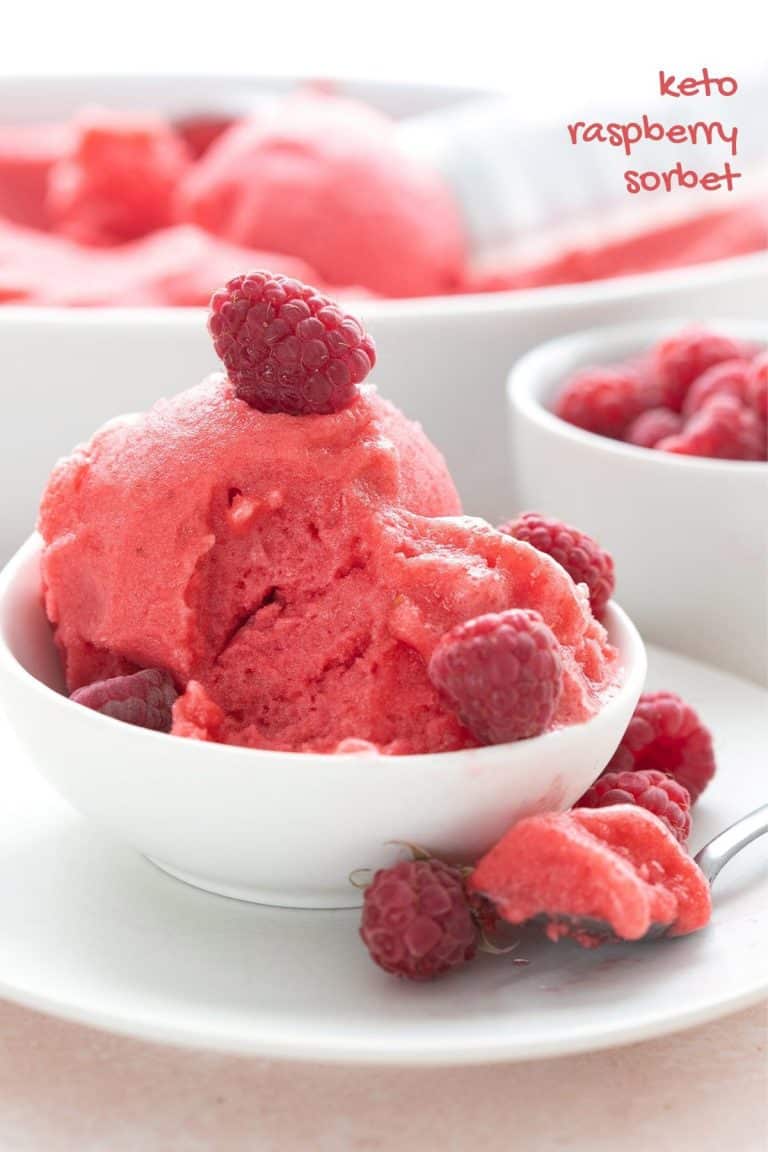
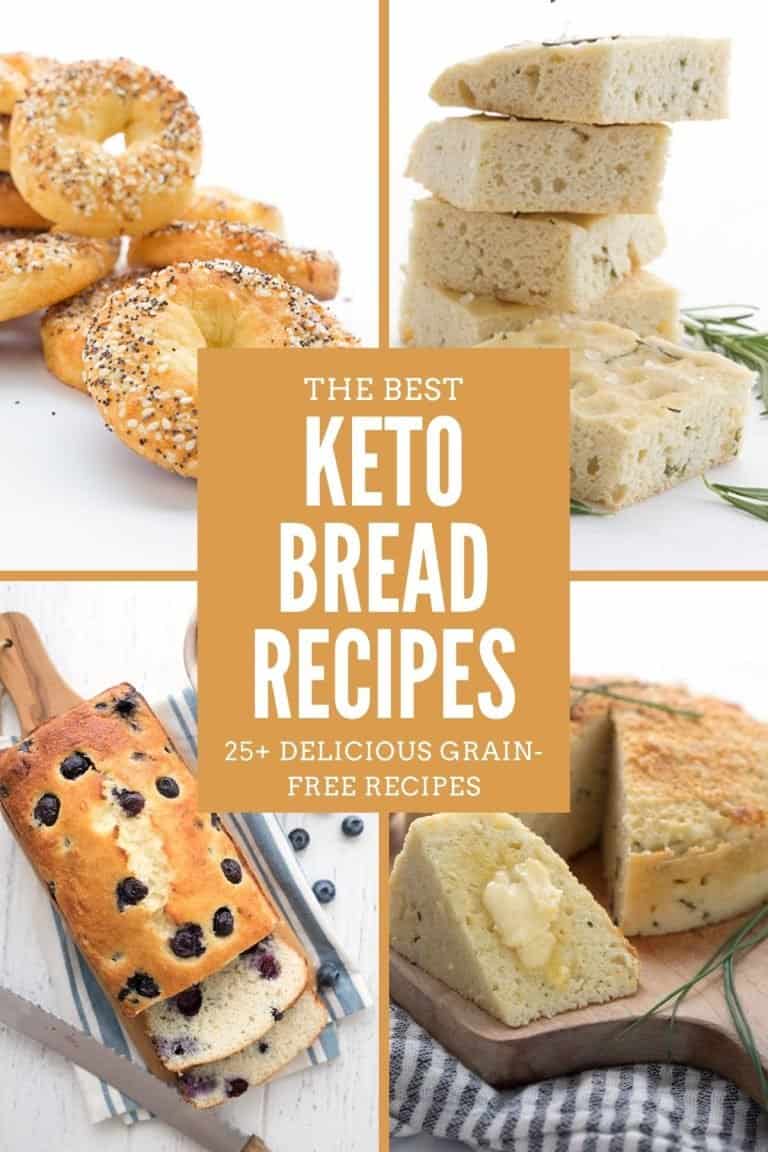
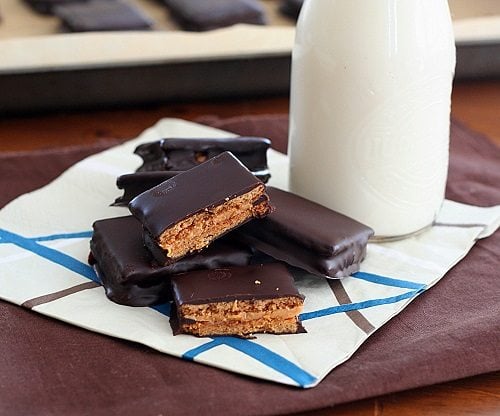











Hi Carolyn! My recipe calls for powdered Allulose but I only have liquid (yes, I’m aware that in many cases liquid cannot be substituted for dry but it’s fine for this recipe). Would I still use the exact same volume of liquid? Is it an equal conversion???
I really can’t say, especially as I don’t know what recipe we’re talking about.
Thanks, this was interesting information. I can’t stand erythritol because of the aforementioned aftertaste and weird cooling sensation. So if I read the information correctly. there are some desserts that I just won’t be able to make since I won’t use erythritol? I’ve just about given up on making keto desserts because they’ve all turned out terrible. None of which were your recipes.
Yes, you read that correctly. I am sorry to say… I wish I could make everything work with every kind of sweetener, but…
Thank you for this article – very interesting!
I have a question about monk fruit – how does it compare to stevia in its sweetening ability? I’ve been using Gentle Sweet stevia blend for years, and recently tried Monk Fruit from Costco, but I’ve been having a lot of trouble with converting the measurements from one to the other.
Is it true monkfruit extract or a blend with erythritol.
Sure would help if this had been done like a recipe so that it’s PRINTABLE.
This article is far too long and involved to make printable. There is no card like a recipe card in which to do so. I suggest you cut and paste the separate paragraphs into a word doc. Pretty easy to do!
FYI, Holley, using all caps in the word “printable” makes it seem as if you are shouting. Next time, consider thanking the person who took the time to give you loads of information for free rather than admonishing her.
Good morning! I love your recipes and have found them to be delicious. I am trying to go low carb and my mother is diabetic. I want to make your Cranberry Walnut Tart. It calls for allulose but I only have Swerve. Can I use swerve instead? If so, is it equal amounts?
Much appreciate your time and knowledge!
Anne
If you use all Swerve, it will recrystallize upon cooling. You’re welcome to do so as long as you know that. And yes, same amount.
Hi Carolyn,
I am from Holland and i love your daily blog and your creations.
I can’t get swerve in Holland. Do you know which sweetner comes close to swerve? We have Greensweet, sukrin,stevia and some other sweetners.
Xxx
Sukrin is mostly erythritol so it’s your best bet. I’ve never heard of Greensweet! 🙂
Hi Carolyn,
I have tried some of your recipes and they are great. I like using erithythol sweetener but it gives me a terrible headache. I know your not a doctor but do u have any suggestions on how to combat this. Don’t want to switch to something else because of the gi issues.
What sweetner do you use?
I use a number of them. That’s why I know how they each work.
This is very helpful. I’m new to keto and this sweetener issue can be very confusing. It seems like every time I go to a new recipe, the recipe calls for yet another type of sweetener! I told my husband I need a “Keto Pantry”, just to store all the different flours, sugars, etc. So I’ve never figure out why this recipe calls for this sugar, that recipe calls for that sugar, etc. Maybe someday, someone (you?) should come up with a 0 carb, all purpose sweetener!! I’m going to save this to refer to, so thank you.
I am new to your recipes and blog. I have a lot of Splenda. where is this in your sugar replacer list. I’d like to use it up before I start using the Swerve products I bought.
Thank you.
I don’t use it because it’s not a natural sweetener. It doesn’t bake very well, IMO. You can use it for cakes and muffins, but it may not be great in frostings (which need better structure) and cookies.
I posted a question earlier about Allulose, when I scan it with the Carb Master app. it says it’s not Keto friendly,maybe like you said earlier ” it’s new”, so maybe they are not subtracting the Allulose carbs to get a net carb?
They are not wrong, in the sense that is HAS carbs… but those carbs are eliminated from the body without affecting blood sugar, so should be subtracted. carbs that don’t act like carbs, if you will.
I’m having trouble understanding Allulose. The lable says 0 calories, 8 carbs, 0 fiber, 0 sugar alcohol, so if you subtract fiber or sugar alcohol to get your net carb., if neither are present. what happens to these 8 carbs , how are they not counted? Does the 8 carbs of Allulose get subtracted from the 8 carbs? I’ve never heard of subtracting Allulose to get a net carb?
Sorry, I rambled, but I need to get a grip on all this as my A1C & wt. have been creeping up & I just can’t seem to get a handle on it. Love your blog.
Allulose should be subtracted entirely, as it has zero impact on blood glucose (and, in fact, can lower it slightly). Just like erythritol.
Why don’t you use sucralose or include it in your assessment of sweeteners? It is so much more reasonable in price and I have used it in baking with a lot of success. Is there a reason you don’t like it?
Because it’s not a natural sweetener.
I don’t understand, your use of “natural”, I was under the understanding that there is no regulation on the word “natural”, that is why I use organic as much as I can, but lot’s of luck finding organic low carb sweetener
Natural = no man made like sucralose or aspartame. Natural as in naturally occurring.
Love your recipes! They are the best!
Thank you!
Does anyone have experience with mixing sweeteners that cause GI symptoms so you use less of each? E.g. 1 part each, xylitol, allulose, and Bocha. Might this work to lessen the GI effects or would it be the same as a full measure of one or the other?
Many of these cause the same GI issues so mixing them won’t really help. Mixing them with erythritol, however, might since it’s known to cause less GI distress.
I wondered if they each cause GI distress via different mechanisms so they might not have an additive effect. You wrote that xylitol and Bochasweet are both pentose sweeteners so perhaps they would be additive but perhaps one of those mixed with allulose would not? Do you know what the mechanism is for each in causing GI symptoms?
Hard to say but I do also think that individual gut microbiome plays a roll in why some people have GI upset for various sweeteners and some do not.
Thank-you for this! I was diagnosed pre-diabetic a few months ago and have been trying recipes with all these sweeteners ad was soooo confused about them all. Is there any way you can make this as printable info. I like to have a hard copy of things like this for reference. If not I tried to write everything down, hope I got all this info. Again thank-you for this!
YOu can cut and paste it into a word doc.
Hi, I just found your website. I’ve been reading a WheyLow. They call it sugar made healthy. Have you tried it or do you know anything about it?
I have not tried it. It’s not as easily available. But given that it actually contains sucrose and fructose (both real sugars), I am skeptical of it.
Question about allulose: when you say “GI upset” do you mean a stomach-related upset, or are you referencing a bowel-related upset? Or, do you mean both? I typically have a bowel-related upset with sugar alcohols, but not a stomach upset.
I think it depends on the person, as it does with all of these sweeteners and how we experience them. I had some bowel related issues with allulose at first but I no longer do. Weird but true!
What sweetener would you recommend for pumpkin pie ?
I’d probably do a mix… Swerve Brown for the brown sugar color and flavor, and then some BochaSweet or allulose to inhibit recrystallization. Half of each.
What are your thoughts on Pyure sweetener?
It’s smells like heaven and it’s twice as sweet only. Bit you do have to use only half as much.
It’s not my fave, personally… but you are free to use it. The only trouble with using half as much is that it means you only get half as much bulk… which can affect consistency.
Is there any way to increase the bulk other than add more sweetener? I follow your recipes and LOVE them, but often cut the sweetener down for our individual tastes. They are still delicious but think the final product is affected by not adding the same amount of sweetener as you do. Specifically your Chocolate Chip Skillet Cookie. I just bought some Botchasweet brown to try. Used erythritol based brown before. Thank you!